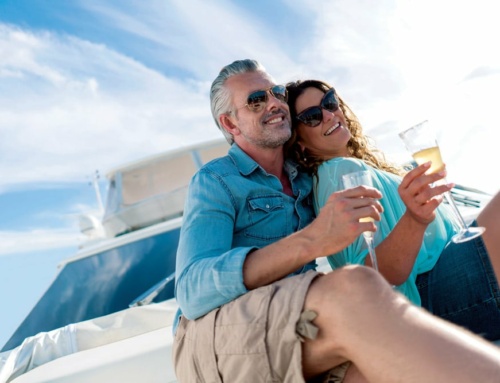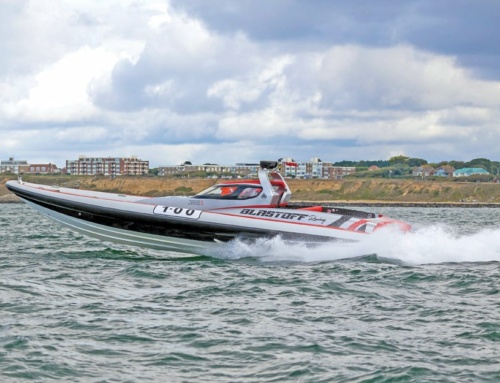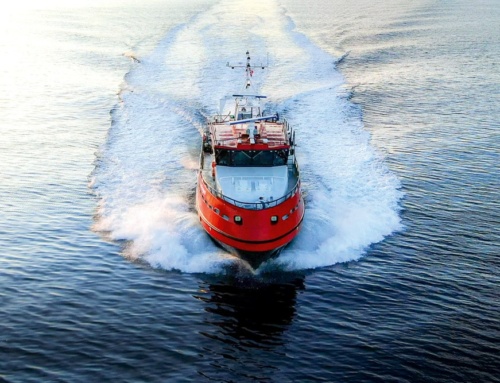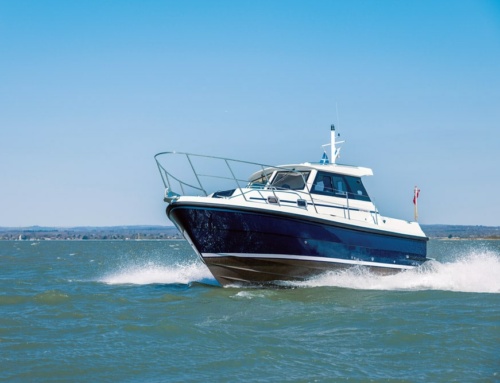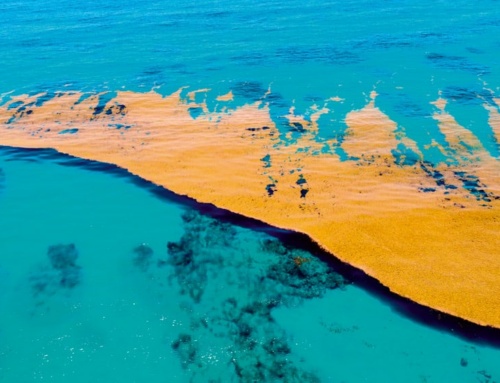- Franz steered towards this non-biodegradable testament to our modern lifestyle and worrying hazard to marine wildlife.
- He methodically pulled all the pollution aboard with his boathook, and I helped pack it away in a sack and a large plastic bucket.
- Tagomago’s bluff sea cliffs are very impressive, and in the right light, the island shimmers like a mirage above the Balearic Sea.
- Getting to such otherwise inaccessible places on a small boat is always a joy.
- My trip to Tagomago was superb, but it gave me a few uncomfortable reasons to be thoughtful.
This Boating Life – Tales of Tagomago
Alex Whittaker slips off to the Med to do some scribbling, but gets sidetracked …
For many years, Mrs Whittaker and I have towed our powerboat behind the family car to the Med. We are always scouting new Med summer locations for our trailer boat. We have been very fortunate to visit quite a few special Med islands this way, and that excitement never palls. However, up until last summer, one fabled island had always eluded us – one that lies off our beloved Ibiza, with the mesmerising name of Tagomago. Roughly translated, this means ‘Rock of Magic’, and that alone is enough to conjure up all kinds of exotic connotations. Furthermore, this name is reputedly linked to noble Hannibal of Carthage. This is because his brother, Mago Barca, is said to have snatched back the island from the Romans.
Situated at 39° 1′ 59.99″ N, 1° 39′ 0″ E in the Balearic archipelago, just off modern Cap Roig, Tagomago is only 1,525 metres long and a mere 113 metres wide. Although it is now a millionaire’s private island – with all local trip boats strictly prohibido – you could certainly get right around Tagomago on your tender on a calm day. After all, Tagomago is only about 900 metres off the Ibizan coast. It is very rocky, with a tiny stone dock, and a white lighthouse to the south-east, which is about 86 metres above sea level. Tagomago’s bluff sea cliffs are very impressive, and in the right light, the island shimmers like a mirage above the Balearic Sea.
Chance sighting
For years, on and off, we thought about making the trip to Tagomago. There is something mystical about the name, and it is shielded from the public gaze. Somehow the opportunity to get to Tagomago did not occur, but the desire remained. Then recently, when in Ibiza scouting Med havens for our esteemed editor, Mrs Whittaker and I found ourselves in the neat little Ibizan port of Es Cana. We were standing on the hot and busy stone boat quay, under the palms, awaiting the local ferry to take us to Santa Eulalia. Looking out over the intensely blue sea, we thought that we could just make out what could be the tip of an island. It seemed to lie beyond a rocky headland, but we could not be sure. It looked to be about 8 or 10 miles away. Intrigued, I consulted the trusty Navionics app on my steam-driven iPhone 4. I took it as an omen when the name ‘Tagomago’ popped up. I had not realised the rocky islet was so near. Since no Es Cana ferries or trip boats are allowed to go there, once more I had to put the matter to one side. Little did I know that I would be visiting Tagomago by small boat within a few days.
Enter Franz
Two days later, I was again down at the shore, admiring the comings and goings of the local craft. Right next to the quay is one of the tiniest harbours I have ever seen – more like a swimming pool ringed with palms than a harbour, with a squadron of small boats tied up inside. The gin-clear water showed the depth to be very shallow, and most of the boats inside were not much more than 16 feet long. However, one perky white little GRP fisher boat immediately caught my eye. Despite her Ibizan registration, she was definitely British built. I knew this because, many many moons ago, I had thought hard and long about buying one. Being an unashamed boat anorak, I knew she was undoubtedly a Mayland Fisherman 16 – a real classic. Now Maylands stopped trading a long time ago, but this neat example looked surprisingly shipshape. All that Ibizan sun had not dulled her gelcoat as much as one might have expected. Her stainless fittings were all in place and in good order. Her cabin door was sound, though now fitted with a sturdy hasp and staple. The fibreglass edges had that all-purpose ribbed black binding used on British GRP boats and kit cars when Led Zep were in the charts – all in all, a nifty, well-preserved, affordable British classic. These Maylands have an amazing amount of deck space for such a compact craft. She was certainly equipped for fishing, and frankly was chock-full of gear – the sure sign of an owner who was an enthusiastic fisherman, rather than an indolent day cruiser such as myself.
Anyway, next noon I was returning on the ferry boat from another photographic task, and looking out, I saw this small outboard craft coming from the direction of Tagomago. Glancing through the telephoto lens I was delighted to see it was the white Mayland. She was running nicely and economically on the plane, with her forefoot well out of the water – all accomplished on a modest outboard. Just like Mayland had promised us in their literature all those years ago. I decided to wait until the boat went into port to try to speak to the skipper. I watched him expertly tickle the boat through a very tight harbour entrance. When I say cramped, the harbour is about 50 of my paces long, by just 25 paces wide – bijou, to say the least. Also, it was very shallow: maybe 6 inches under the outboard skegs. The skipper started bringing his catch ashore, so I took my chance. Cheekily, I asked him about his boat. The skipper looked at me and smiled when I said I recognised the boat was English. To my surprise, he was not an ibicenco as I expected. He spoke good English, with a slight German accent. His name was Franz Hopfer. In fact, Franz is Austrian, but has lived and worked on Ibiza for many decades. He has a fine house, just up from the harbour. He was clearly amused at my ‘anorakish’ knowledge of his little boat, and invited me aboard. She was a little cracker. When I asked Franz how she had stayed in such good condition for so many years under the punishing Mediterranean sun, he told me the story. The previous owner had bought her in Germany, new, from a boat showroom on the Rhine. The owner brought her over to the island. Then, since his wife thought the boat bobbed about a bit too much, he promptly lost interest in boating. The little Mayland was tucked up in a tarpaulin under a palm in a back garden, and stayed there for the best part of 30 years. When Franz bought her he had to reregister her with the Ibizan authorities. He even had to get professional line drawings done of the hull and super so that the legal documents were correct. Franz goes sea fishing any time he can spare from his day job, but hopes to retire soon. We are about the same age, and have a similar boating madness, so we hit it off immediately. Fellow sufferers tend to recognise each other, no matter what their nationality. Franz invited Mrs Whittaker and me to dinner at his house the next evening. It was a lovely meal of fresh fish, caught and cooked by Franz, and was taken in the garden, on a perfect Ibizan night. Over the champagne course I cheekily asked Franz whether he knew Tagomago. ‘I will take you tomorrow,’ he said, and that was that.
Tagomago bound
Back on board next morning, the little Honda 40 4-stroke was purring away like a sewing machine running on liquid honey – a lovely motor, prized by Franz, and a bit of a classic in itself. Franz said it was one of the first to be imported to Ibiza.
It was now time to cast off. Ever cautious, even under the Mediterranean sun, I set the Navionics chartplotter app on my iPhone to ‘Trip’ mode. This was to record our track and give me a constant read-out of our position. I had even remembered to bring my mini handheld VHF with me. This greatly amused Franz since he wondered whom I might wish to call to rescue us. Apparently, local powerboaters mostly rely on their mobile phones and each other for mutual support. I got the impression that there were commercial ‘get-you-home’ services for posh marina dwellers, but they were a bit pricey. Thus the local lads stick together.
Another safety point was life jackets. I did not have a gas-operated life jacket with me, since Mrs W and I had EasyJetted out to Ibiza. I noticed that morning in the tiny harbour, among all the local boats raring to go, that absolutely no one was wearing a life jacket. Franz said he had two or three below in the cabin, but seemed not in any hurry to don one. The Mayland was moored in the usual Mediterranean nez à quai style, with the sharp end tied to the quay, and the blunt end made off to an underwater line. Franz expertly cast off both lines from the cockpit, and reversed her out. It was like manoeuvring a sardine inside a full can, but he did it with slick familiarity, and we left Es Cana, avoiding the swimmers, lilos, trip boats, ferries, dive boats, personal watercraft, snorkellers, kite surfers, pedalos and powerboats. Finally, we headed to fabled Tagomago.
Es Cana is a delightfully minimal port, in that relaxed Ibizan way. Its little stone quay dotted with palms looked superb in our wake. We had to pass a few dramatically handsome offshore rocky outcrops. Then we zed-bended skilfully around a rocky reef, its angry comb just breaking awash. Thence we shadowed the coast past Cap Roig. On the way we came upon Paco and Luis, also from the tiny harbour. They were fishing with light rods and fixed-spool tackle from a well-found 5m Astec RIB equipped with a 50hp Mariner. Greetings and jokes were exchanged in Spanish, and we moved on. It was about 30 degrees, with a bit of a breeze and weak sunshine, and we were soon gently on the plane. The Mayland is a proper little ship and had pushed easily through her own bow wave. After about a 7-mile run we got closer, and the sheer sides of Tagomago looked bluish grey in the haze. I was so glad to be this close, and just drank it all in. It was quite a moment for me. It soon got very bumpy on the seaward side of the rock, and Franz stopped to bait his lines. The high cloud burned off, and at last I could get a good look at Tagomago. It was certainly a massive crag rising out of the water, but its cracked and fissured sides appeared to be made up of at least two types of rock. When a shaft of sunlight broke through the colours, the panels and striations in the rocks changed hue to red ochre, burnt umber and taupe. Getting to such otherwise inaccessible places on a small boat is always a joy. We could see no signs of man or habitation this side of Tagomago.
Oddly, wildlife seemed scarce too. There were no cormorants or noisy seabirds atop the steep rocky faces. In fact, compared to North Wales, local wildlife seemed muted and rather sparse. Incongruously, there was quite a colony of hawks slope-soaring off the cliffs. I am no bird expert so could not identify them. They had squarish tails, light breasts, dark plumage and sickle-shaped wings. My camera lens, chosen for the boat and the seascapes, was far too short to get a good shot. Maybe these occupational killers had scared off Tagomago’s other feathered inhabitants. Perhaps these raptors were hanging about up there ready to devour any exhausted birds of passage from Africa. As we cleared the headland, a magnificent white lighthouse rose over the rock face. It proved to have twin buildings at its base. These had Romanesque pantile roofs, surrounded by a stone wall. I had been told that the millionaire owner of Tagomago had installed a helipad. This was for his millionaire pop star and footballer paying guests, who use this island for their exclusive parties and marriages. This sunny side of Tagomago looked too sheer to make a landing.
Octopus for supper
Anyway, it was now getting a bit rough. Franz is a canny fisherman, so he had soon hauled in enough for our dinner that night. He had also caught a little octopus. This had fought like a demon and came up still clutching its solid-rock anchor. Octopus is considered a delicacy in these parts, so I looked forward to tonight’s dinner with interest. We coasted around to the shadowy side of Tagomago, which had rocks awash, and then a crescent-shaped scoop out of it. Franz told me landings used to be made here years ago when Tagomago was a trip boat destination. On this side of the island the water was an uninviting steel grey. It reminded me of a flooded Welsh quarry. The derelict staging, the old stone quay and the rather depressing decrepitude of the old cafe told their own stories. I thought this was distinctly at odds with the island’s new ‘millionaires’ playground’ billing on Google. Tagomago’s carefully constructed public relations mask of a hedonistic jet-setter had slipped just a bit.
Plastic pollution
It was getting a bit lumpy, we had achieved our objective and the day was advancing. We set back towards the mainland. The game little Mayland pushed through large waves at a jolly pace. About halfway across we saw a floating mass in the water. On closer inspection, it was a raft of plastic rubbish on the sea – plastic netting, fishing traces, fishing line, foam plastic floats, beer can wrappers, blue nylon line, poly bags and water bottles. All clogging up this beautiful part of the ecosphere. All the more worrying because I know from my own eyes that all the Balearic Isles have a dedicated fleet of inshore municipal boats that spend all day efficiently scooping such rubbish from the sea. They really are trying hard, but it is necessarily a response, and ‘after the fact’ of the rubbish already having been deposited. Franz told me he has seen dead turtles entrapped and killed by this trash. He told me sea mammals ingest it too. Recently a whale had washed up ashore, and Franz reckoned that a diet adulterated with plastic had contributed to its demise.
Franz steered towards this non-biodegradable testament to our modern lifestyle and worrying hazard to marine wildlife. He methodically pulled all the pollution aboard with his boathook, and I helped pack it away in a sack and a large plastic bucket. We took our leave of Tagomago. It did look magnificent. Back at the harbour, Franz and I put the rubbish in the quayside rubbish bins. Young holidaymakers in their 20s were clearly concerned, and came to offer their help. This was very encouraging. The new generation do seem to have got the anti-pollution message. My trip to Tagomago was superb, but it gave me a few uncomfortable reasons to be thoughtful.
Back In North Wales
Back home, our youngest crewmember, granddaughter Bethan, had independently been doing her own marine clean-up project. She lives on the coast near where we keep the family Bayliner. She had seen the BBC Blue Planet II film about marine pollution, and had been out on the beaches with a grabber and a stash of rubbish sacks. Since she is six, she hopes to get a Blue Peter badge too. Again, this cheered me up, since all hope rests with the younger generations like Bethan, and her mum and dad. Sea pollution really is everyone’s problem.
Cockpit cover prop
Our ace new bespoke waterproof cockpit cover is working well. However, there is one small problem. The existing Bayliner-supplied support pole (prop) tends to slip about on the rear deck. This means that rainwater is not shed properly, and ‘pools’ on the cover. Luckily this does not leak in, but it is applying unnecessary strain to the new cover. I soon started casting about for a low-tech fix. My RIB-owning mate Steve Potten was sitting on the back deck with me at the time. As usual, we were eating our alfresco gentleman’s luncheon of pork pies, Scotch eggs, petrol station sarnies and supermarket cream cakes. Potten said he had a solution – one that has worked under his own RIB covers for decades. He went home (only about a mile away) and quickly brought back an old photographic tripod. Apparently it dates from the 50s. On top he had fitted a rubber turntable mat from a record player. This acts like a huge washer, to hold up the cover from the inside, and thus spread the load over a larger area of the fabric. Since the pad height is minutely adjustable to achieve exactly the correct cockpit cover tension, it all works rather well. If you don’t have one gathering dust in your garage, such tripods can be bought cheaply from eBay, or indeed cadged from mates. I prefer the latter.
Porous manifold
In the last issue I mentioned the importance of having a professional inspect your marine engine at the time of the annual service. Well, when I had trusty Lee Mercer of CML Marine Ltd check over our MerCruiser petrol engine, he found rust stains on a key component. Further investigations drew indications of porosity in the engine water-cooled manifold. He duly stripped out the suspect manifold and found that it was indeed very close to cataclysmic failure. A new MerCruiser manifold had to be ordered, and Lee duly fitted it for us. It was a costly item to buy – about £400 plus labour – but such an ingress of water could ruin your engine, or even sink your boat. Of course, I will now have to think carefully about replacing the manifold on the other side of the V8. If a manifold were to give up the ghost at sea, we might have trouble getting home, so I think the new one was money well spent. However, as usual, everything in powerboating always seems just a bit dearer than one would like.
Marina update
Last time, I promised I would keep you in the picture about the change of ownership of our little marina in North Wales. Well, I have to say that Lakeland Lakes and Leisure, the new owners, have been every bit as good as their word. Their first act was indeed to reduce our berthing costs. They have also set about sorting out a berth holders’ lounge, and they have instigated upgrades to the existing Wi-Fi system. They invited all current berth holders to a Lakeland welcome bash. We turned out in our droves. Some cynics cited the free food, free musical entertainment and free bar laid on by the new owners. However, I think we berth holders were genuinely interested to hear what Lakeland had to say. We sat and listened, and asked questions. Mrs Whittaker and I have been around the block with marinas at home and abroad, but we both came away very encouraged. So much so, we renewed our berth holders’ contract with Lakeland the following week.
Action shot
I have enclosed a photo taken by my mate, the aforementioned Steve Potten, using his GoPro camera. I was trying to get a ‘boat-to-boat’ action shot of marina mate Colin Bennett blasting along on his classic Fletcher. It was taken from the deck of my previous Bayliner 2052 Cuddy. It’s tough being an overpaid superstar modelling journalist …
The author
Alex Whittaker is PBR’s Mediterranean cruising correspondent and Pilot Guide scribbler. His current boat is a Bayliner 245 Ciera kept at Deganwy Marina. Alex likes anything that floats, and has never knowingly walked past an uncorked wine bottle …


